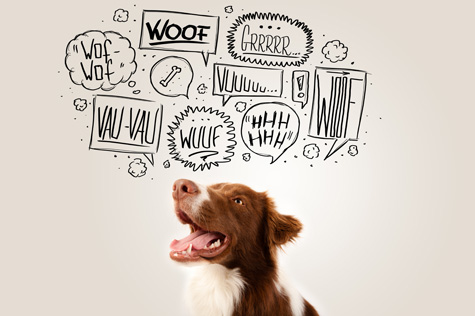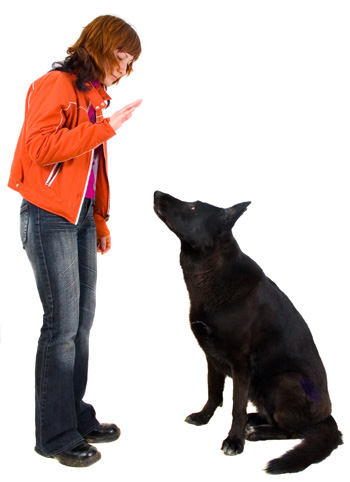Bark Bark Bark! Why Your Dog Barks and How To Fix It
Posted by Hot Dog Collars on 12/05/16 11:38 AM
 Barking is a natural way for dogs to communicate their emotions. While
it's something to be expected, excessive barking can be troublesome for pet
owners and annoying for neighbors. To manage your pet's barking issue, it helps
to understand why canines bark to get to the root of the behavioral
problem.
Barking is a natural way for dogs to communicate their emotions. While
it's something to be expected, excessive barking can be troublesome for pet
owners and annoying for neighbors. To manage your pet's barking issue, it helps
to understand why canines bark to get to the root of the behavioral
problem.
Common Reasons Why Dogs Bark
Dogs use various types of vocal communication, including howling,
grunting, whining, and barking. Younger pups tend to make loud crying noises,
especially when they feel upset. Some breeds are more inclined to bark easily
due to the way they have been bred and trained as watchdogs or herding
dogs.
Dogs bark in response to a variety of situations. Here are the most
common reasons associated with barking in dogs.
Protective of a territory: An unwelcome individual, whether a person or
animal, that enters a dog's personal territory may cause the canine to bark in
an agitated manner. The barking gets more intense as the perceived threat draws
nearer. Dogs may get aggressive as their defensive instinct kicks in.
Alerted to danger: Dogs are generally encouraged by most pet owners to
bark loudly if they sense some form of danger. Some dogs bark a lot when they
get startled due to sudden noise or movement, and their barking gets into a
rapid pace as the source of danger approaches. When dogs transition from
warning barks to aggressive barks, their barking lowers in pitch and combines
with growling.
Annoyed when not given a coveted object: When you're eating a delicious
hamburger and your dog keeps barking at you, it's very likely that your
rambunctious pet wants the same food you're enjoying by yourself. Besides food,
dogs may bark excessively when they do not obtain certain things at home or
anywhere else, especially objects that they want to bite and chew.
In want of your attention: Dogs will bark to grab your attention,
particularly when they want to go outside, play with you, or have a
treat.
Playful and excited: Barking that involves tail wagging and a bit of
jumping indicates happiness and excitement, like when greeting other people or
dogs. A happy bark is typically short and sharp.
Responsive to other dogs: You may have observed that your dog tends to
bark abruptly in response to the barking of other dogs. Your pet behaves this
way in order to let the other dogs know of his presence.
 Bored: When you leave your dog at home for hours without letting him
play, he may get bored and start barking. Dogs require stimulating activities
to release pent-up energy.
Bored: When you leave your dog at home for hours without letting him
play, he may get bored and start barking. Dogs require stimulating activities
to release pent-up energy.
Lonely and anxious: Dogs love to stay close to their owners, which is
why they may bark excessively when separated from their owners for long
periods. Dogs suffering from separation anxiety do not like being left alone,
and they show symptoms such as depression, aggressiveness, and improper
elimination.
Compulsive behavior: Some dogs are compulsive barkers, which means they
actually like to hear how they sound like. They typically also like to run in
circles and do other repetitive actions.
How to Stop Excessive Barking
Controlling your dog's barking behavior doesn't happen overnight. You
need much patience and perseverance to train your pet to bark lesser and lesser
by the day. Also, you may find it tougher to manage excessive barking if your
dog is predisposed to the behavioral problem due to his particular breed.
Common dog breeds that are prone to barking include beagles, fox terriers,
cairn terriers, Yorkshire terriers, and West Highland white terriers.
When training your dog to minimize barking, remember to talk in a calm
yet resolved manner. Avoid yelling or scolding your pet, as this still comes
across as encouragement for your dog to keep on barking. Be consistent when
instructing your dog not to bark at certain noises, movements, and situations.
Also, go with positive reinforcement which rewards good behavior instead of
punishing bad behavior.
Follow these steps to promote an obedient behavior and reduce barking.
Use word commands.
While your dog barks, say "quiet" calmly and firmly. Always
use the same tone when saying this command. Wait for him to stop barking; the
moment he stops -- take note, NOT while he barks -- praise him immediately and
offer a nice treat.
 Repeat this method until your dog understands that he receives a
delectable treat when he stops barking after hearing you say "quiet."
Over time, offer verbal rewards in place of food treats. You may pat your dog's
head, scratch his belly, or tell him he's a "good dog" to give him an
incentive to follow your command.
Repeat this method until your dog understands that he receives a
delectable treat when he stops barking after hearing you say "quiet."
Over time, offer verbal rewards in place of food treats. You may pat your dog's
head, scratch his belly, or tell him he's a "good dog" to give him an
incentive to follow your command.
Train your dog to stay in a corner.
Teach your dog to stay in a particular spot, ideally an area where he
can see the door but not get too close to it, if he likes to bark excitedly
whenever you come home or a visitor stops by. Make sure to avoid petting your
dog, making eye contact, or offering any kind of reward until he sits quietly.
Like teaching word commands, use delicious treats and positive praises
to encourage obedience. Ask help from a family member or friend who will act as
a visitor and help you with your training sessions.
Limit what your dog sees.
If your dog usually barks from being protective of territory or being
alerted to danger, such as catching sight of a passerby or spotting the mail
carrier, try to prevent him from seeing people who come to your home. Replace
chain fencing with solid wood and install a frosted window film to ensure your
dog doesn't get startled by passersbys.
Provide entertainment and companionship while you're gone.
Make sure your dog is entertained enough while you're out for hours,
especially if your dog gets easily bored or experiences separation anxiety.
Provide fun activities and interesting toys, such as food-dispensing toys. You
may want to hire a trusted pet sitter who can be a fun and reliable companion
for your dog.
Alternatively, ask a friend to play with your dog or walk him to the
park for one hour when you're running errands or at work. Moreover, explore
options such as using video chat technology that allows pet owners to
communicate with their pets while they're in the office and on the go.
Do not give in to attention-seeking behavior.
When you do what your dog wants every time he barks, he will consider
barking as an effective means to get your attention. Instead of caving into his
demands, find other ways to make communication between the two of you easier.
For example, if he barks at the door whenever he wants to go outside, tie a
bell to the door handle, teach him to ring it, and only allow him to go out
when he rings the bell.
Expose your dog regularly to certain sounds.
To handle startled barking, record the sound that usually makes your dog
agitated and triggers barking, and play it back in low volumes to help your dog
feel relaxed while listening to it. Give him a reward when he stays quiet. Play
the sound more loudly as time goes by until your dog gets accustomed to the
sound.
If you've tried everything else and you've exhausted numerous options
without getting significant results, it's a good idea to seek help from a
certified animal behaviorist, veterinarian, or professional animal trainer.
Compulsive barkers and dogs with separation anxiety, in particular, may need
the most help from qualified professionals.

